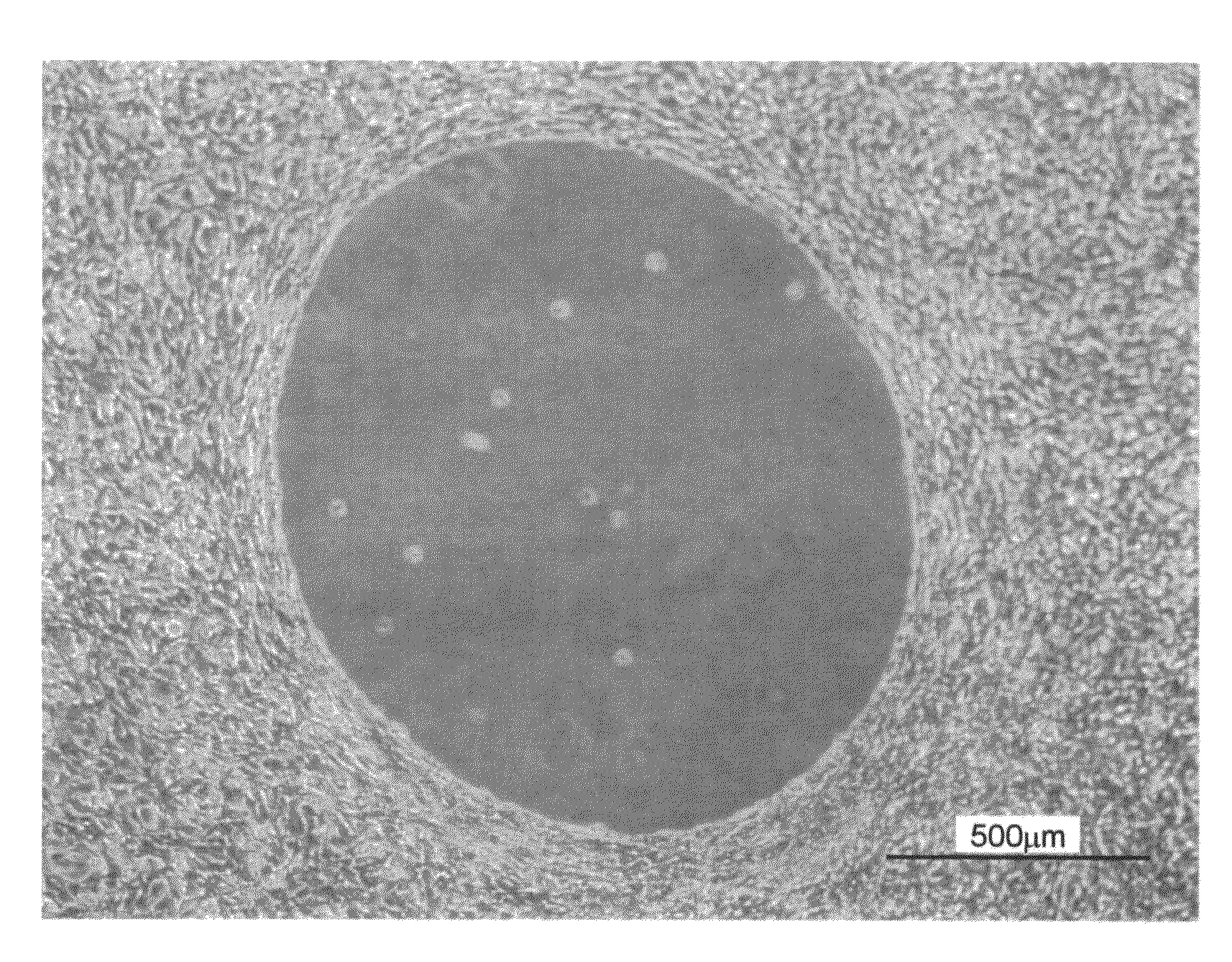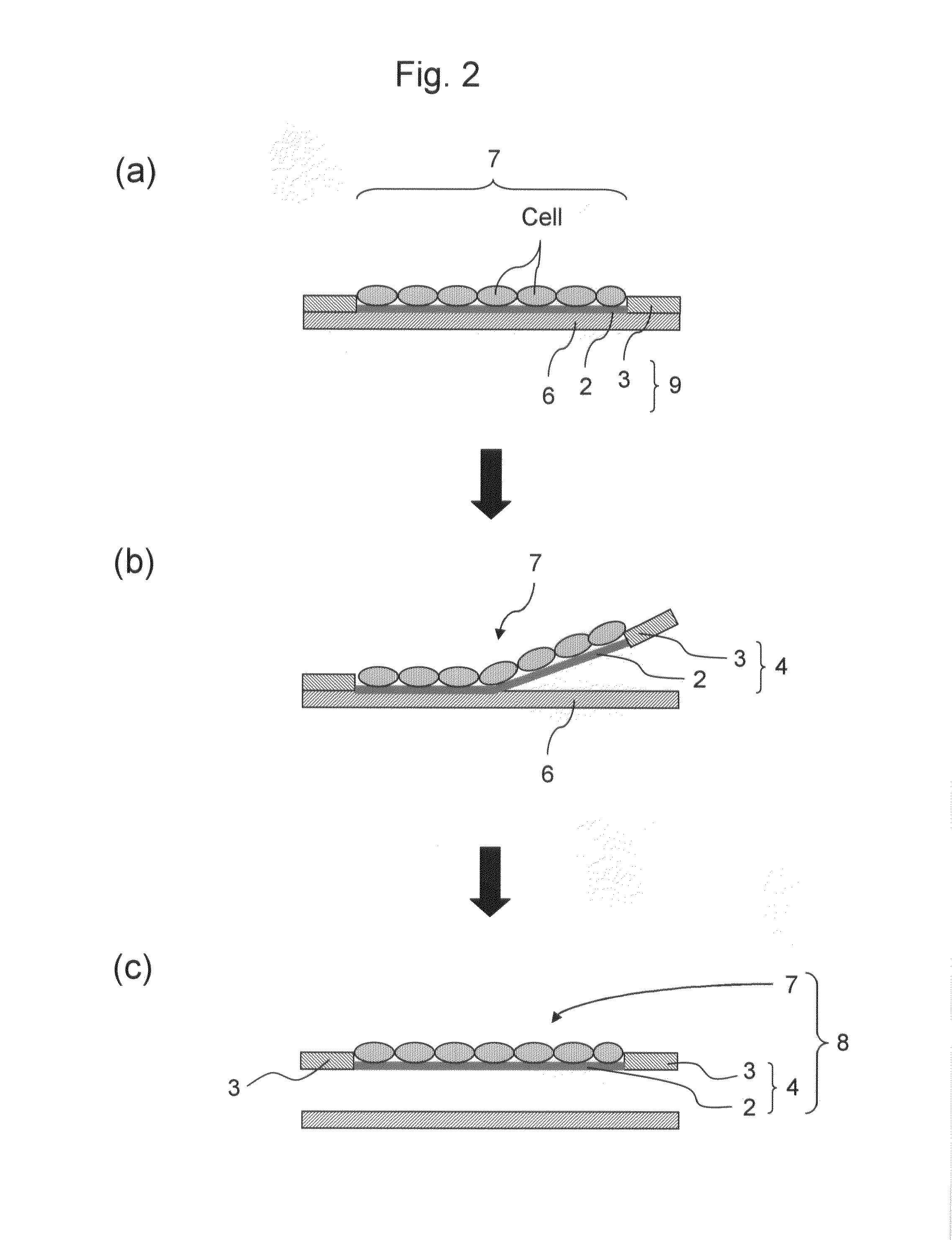Cell sheet having good dimensional stability, method for production thereof, and cell culture carrier for use in the method
a cell sheet and dimensional stability technology, applied in the field of cell sheet having good dimensional stability, cell culture carrier for use in the method, can solve the problems of inability to provide cell sheets that can be appropriately multilayered, no satisfactory techniques whereby cell sheets can be readily detached from cell culture carriers, and no satisfactory cell sheets. the effect of thickness
- Summary
- Abstract
- Description
- Claims
- Application Information
AI Technical Summary
Benefits of technology
Problems solved by technology
Method used
Image
Examples
example 1
Collection of a Support-Held Cell Sheet
1-1. Production of a Base Substrate Having a Static Water Contact Angle of 45° or Less and Cell Adhesion Inhibitory Properties
[0079]Toluene (39.0 g) and TSL8350 (GE Toshiba Silicone Co., Ltd.) (0.8 g) were mixed together and triethylamine (450 μl) was added thereto during agitation. The resultant was continuously agitated at room temperature for several minutes and the full volume thereof was transferred to a glass dish. A 10-cm square glass substrate subjected to UV cleaning was immersed therein and left at room temperature for 16 hours. Thereafter, the glass substrate was washed with ethanol and water, followed by drying with nitrogen blowing. Next, concentrated sulfuric acid (25 μl) was added dropwise to tetraethyleneglycol (TEG) (50 g) during agitation. The resultant was continuously agitated for several minutes and the full volume thereof was transferred to a glass dish. The above substrate was immersed therein, followed by reaction at 80°...
example 2
Comparative Example Regarding the Collagen Content Per Unit Area of Base Substrate and the Type of Base Substrate
[0082]The collagen content per unit area of base substrate was changed from 5 to 150 μg / cm2. In addition, a base substrate comprising polystyrene (cell culture dish; FALCON), a base substrate comprising glass, and a base substrate subjected to chemical treatment by the method used in 1-1 in Example 1 were compared with each other. Except for the above, Example 2 was carried out as in the case of Example 1. Distinction between defective products and qualified products was made based on the following point: whether the majority of cells remained on the base substrate after damage to the collagen thin film caused by removal of the support-held cell sheet from the base substrate; or a cell sheet formed with the majority of cells was obtained without damage to the collagen thin film. Tables 1 and 2 list the relationships between defective products and qualified products. The s...
example 3
Lamination of Support-Held Cell Sheets
[0083]On the support-held cell sheet produced in Example 1, a support-held cell sheet produced in the same manner was laminated in a manner such that a collagen thin film came into contact with cells. The medium was suctioned such that the support-held cell sheet was slightly immersed in the medium. Thus, the support-held cell sheets came into contact with each other via surface tension. After 4 hours for lamination, a medium was newly added thereto such that the obtained multilayer support-held cell sheet was sufficiently immersed in the medium. The above support-held cell sheets were found to adhere to each other so that both sheets were moved together when one of the support-held cell sheets was moved. Similar operations were repeated to laminate 4 layers, followed by culture for 2 days. Then, cells were stained with calcein and observed with a confocal microscope (FIG. 8). As a result, bovine aorta endothelial cells were found to form a netw...
PUM
| Property | Measurement | Unit |
|---|---|---|
| Angle | aaaaa | aaaaa |
| Dimensional stability | aaaaa | aaaaa |
| Adhesivity | aaaaa | aaaaa |
Abstract
Description
Claims
Application Information
 Login to View More
Login to View More - R&D
- Intellectual Property
- Life Sciences
- Materials
- Tech Scout
- Unparalleled Data Quality
- Higher Quality Content
- 60% Fewer Hallucinations
Browse by: Latest US Patents, China's latest patents, Technical Efficacy Thesaurus, Application Domain, Technology Topic, Popular Technical Reports.
© 2025 PatSnap. All rights reserved.Legal|Privacy policy|Modern Slavery Act Transparency Statement|Sitemap|About US| Contact US: help@patsnap.com



